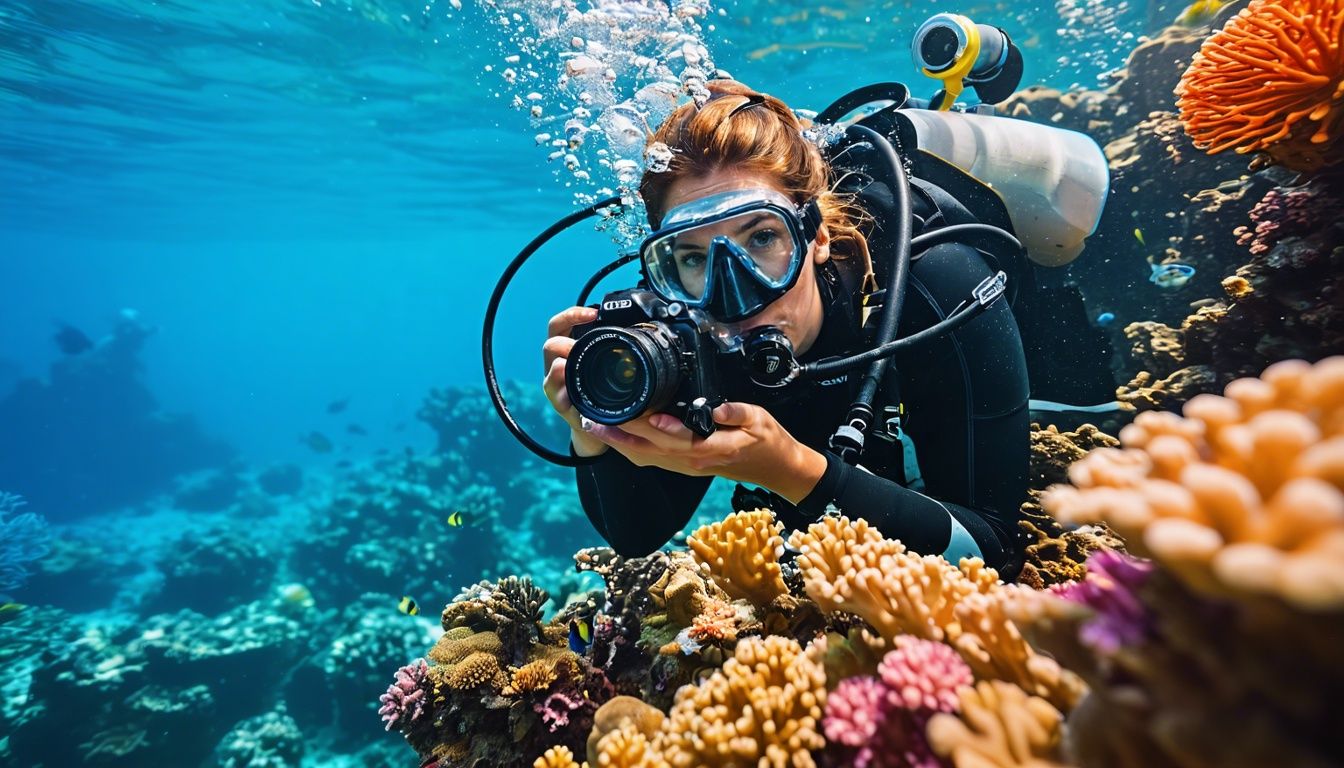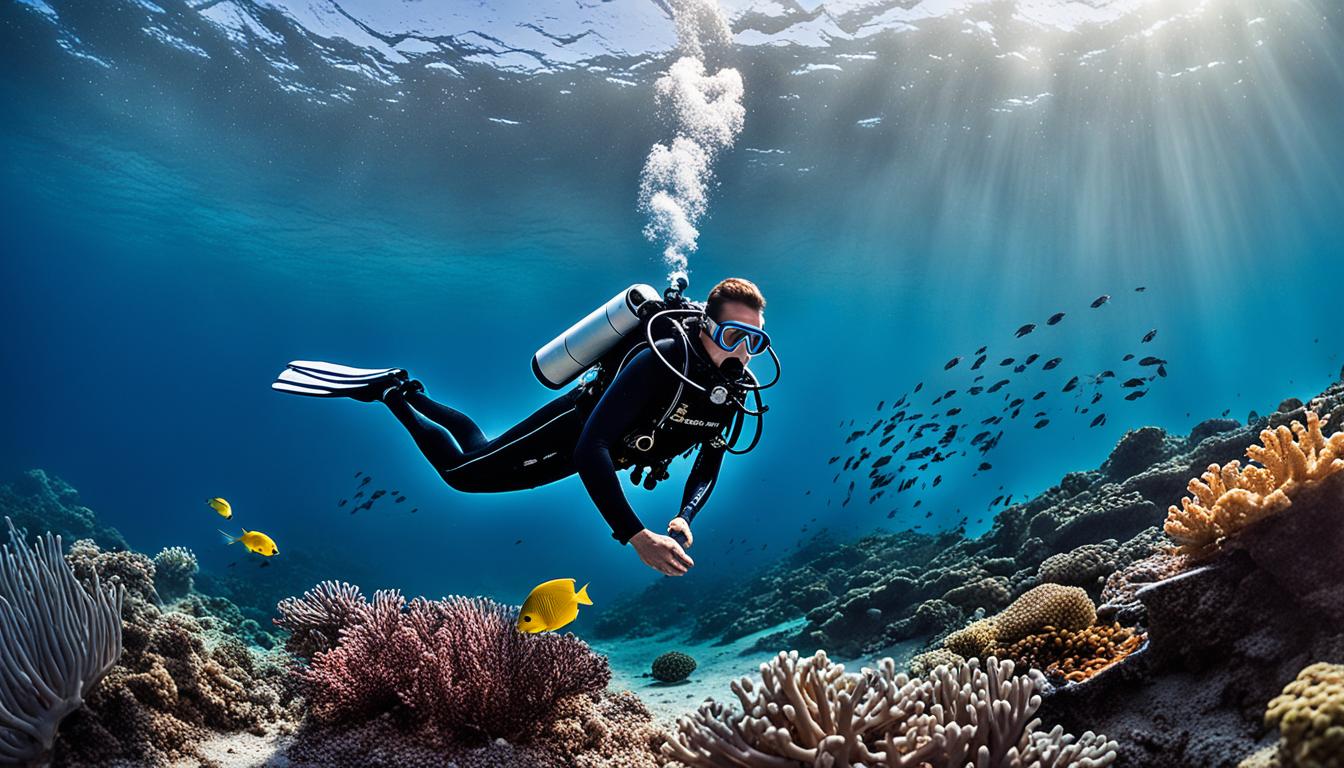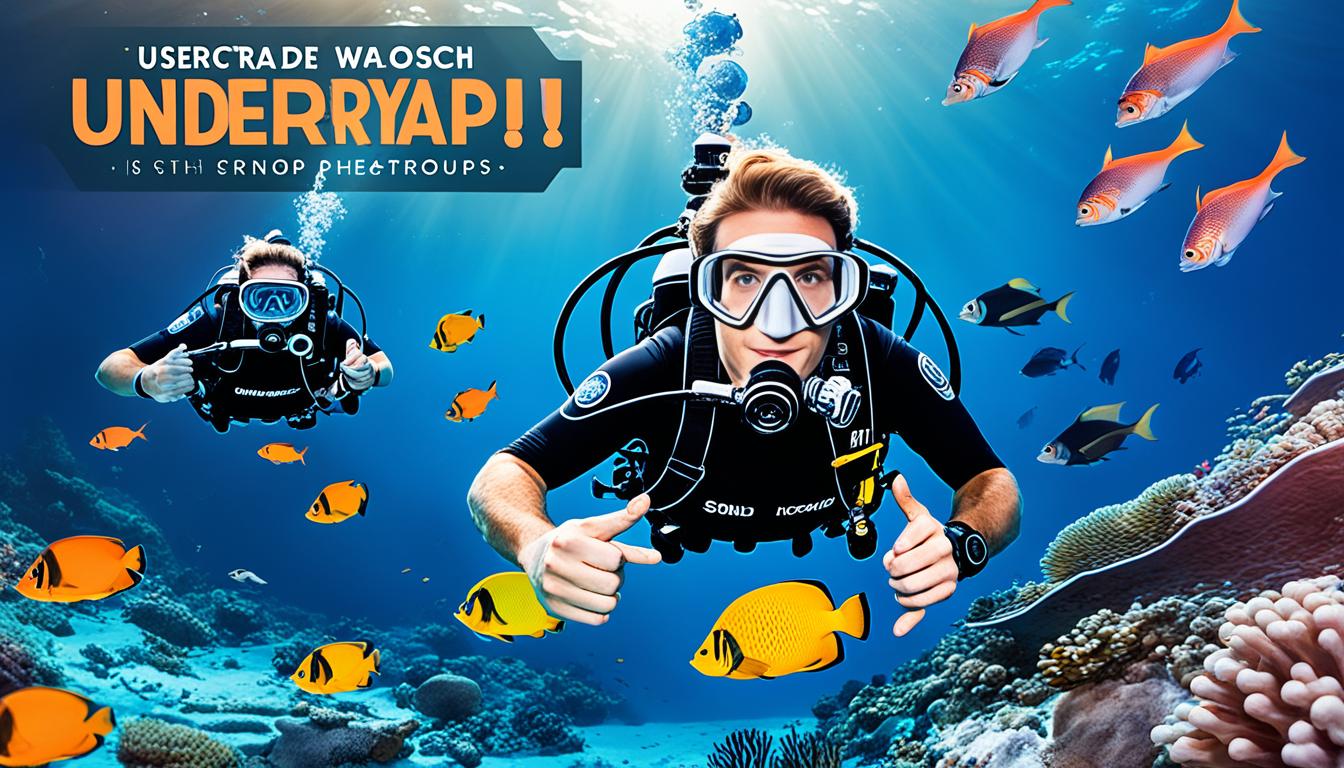Underwater photography is a captivating art form that allows us to explore the breathtaking beauty of the underwater world. Wide-angle underwater photography, in particular, presents a unique set of challenges and opportunities. It requires a combination of specialized gear, knowledge of camera settings, lighting techniques, and careful composition. In this article, we will delve into the essential tips and tricks to help you master the art of wide-angle underwater photography.
Key Takeaways:
- Wide-angle underwater photography requires a wide-angle lens, proper lighting, composition, and camera settings.
- Essential gear includes a dome port, two strobes, and a fisheye or wide-angle lens.
- Manual mode is preferred for shooting with strobes, allowing control over aperture, shutter speed, and ISO for desired exposure.
- Strobe position and adjusting lighting play a crucial role in achieving the desired effect.
- Composition is vital, considering foreground and background subjects, leading lines, and spirals for visually appealing photos.
Gear for Wide-Angle Photography
When it comes to wide-angle underwater photography, having the right gear is essential to capture stunning images. Here are the must-have equipment for your underwater photography adventures:
Dome Port
A dome port is a curved glass or acrylic element that goes in front of your camera lens. It helps correct the distortion caused by shooting underwater and provides a wider field of view. For fisheye or close-focus wide-angle shots, a small dome port is suitable. However, for rectilinear wide-angle shots or over-under split shots, a larger dome port is needed. This allows you to capture the beauty both above and below the water’s surface.
Strobes
Lighting is crucial in underwater photography. To ensure even lighting and bring out the vibrant colors of the underwater world, it is recommended to use two strobes. Strobes are powerful underwater flash units that illuminate your subjects. They help eliminate shadows and provide the necessary light to reveal the underwater scene’s true beauty.
Fisheye or Wide-Angle Lens
To capture the expansive underwater scenery, a fisheye or wide-angle lens is a must. A fisheye lens provides a distortion effect, emphasizing the curves and depth of the underwater world. Alternatively, a wide-angle lens with a minimum focal length of 18mm or wider can capture a broader perspective while maintaining a rectilinear projection. Both options allow you to create impactful and immersive wide-angle images.
Additionally, if you plan to use a zoomable lens, it’s important to have a zoom gear. This enables you to adjust the focal length while maintaining compatibility with your dome port.
With the right gear in your photography kit, you’ll be ready to dive into the world of wide-angle underwater photography and capture breathtaking images.
Camera Settings for Wide-Angle Photography
When it comes to capturing stunning wide-angle underwater photographs, getting the right camera settings is essential. By shooting in manual mode, we have full control over the aperture, shutter speed, and ISO, allowing us to achieve the desired effect.
“Shooting in manual mode gives us complete control over the camera settings, ensuring optimal results for wide-angle photography.”
To start, we recommend setting the aperture to F8, the ISO to 100, and the shutter speed to 1/125th of a second. Of course, these settings can be adjusted based on the available lighting conditions and the specific effect we want to achieve in our underwater images.
If we find ourselves shooting in low-visibility water or capturing subjects that are further away, we may need to increase the ISO to maintain proper exposure. On the other hand, shooting close-focus wide-angle shots or capturing images directly into the sun may require a smaller aperture.
Another important consideration is the blue color of the water in the background. To capture the true essence of the underwater environment, we should adjust the shutter speed accordingly, allowing for the rich blue tones to shine through.
In wide-angle photography, TTL (through-the-lens) mode is not typically recommended. While it may seem convenient, it often fails to provide precise control over strobe power. By manually adjusting the strobe power, we can ensure better lighting in our wide-angle compositions.

Camera Settings for Wide-Angle Photography:
| Camera Setting | Recommended Value | Adjustment |
|---|---|---|
| Aperture | F8 | Adjust based on lighting conditions and desired depth of field. |
| ISO | 100 | Adjust for low-light conditions or distant subjects. |
| Shutter Speed | 1/125th of a second | Adjust for varying lighting conditions and desired background color. |
By understanding and utilizing these camera settings for wide-angle underwater photography, we can capture breathtaking images that truly showcase the wonders of the underwater world.
Lighting and Strobes for Wide-Angle Photography
Proper lighting is essential for creating stunning wide-angle underwater photographs. By strategically positioning and adjusting your strobes, you can achieve the desired lighting effects and bring out the vibrant colors and details of your subjects.
When it comes to strobes, it’s worth investing in the best you can afford. High-quality strobes not only provide more reliable lighting but also offer more control over light output, allowing you to achieve professional-level results.
In wide-angle photography, the positioning of your strobes plays a crucial role in lighting up the scene. The position will depend on the composition and the desired lighting effect. Here are some guidelines:
- For capturing schools of fish or large scenes, wider strobe positioning is recommended. This helps create even lighting and prevent harsh shadows.
- For close-focus wide-angle shots, tighter strobe positioning is ideal. This enhances the subject’s details and brings out its vibrant colors.
In waters with high particulate content, backscatter can become a problem. To minimize backscatter, you may need to point your strobes slightly outward. This technique helps to prevent the light from bouncing off the particles and causing unwanted specks in your photos.
Another way to ensure even lighting is to use a diffuser on your strobes. A diffuser spreads the light beam, reducing hotspots and creating softer, more pleasing illumination.
Remember, experimenting with different strobe positions, angles, and settings can lead to unique results. Take the time to practice and fine-tune your lighting techniques to achieve the desired effects in your wide-angle underwater photography.
| Common Lighting Techniques | Description |
|---|---|
| Wide Strobe Positioning | Placing the strobes farther apart yields more even lighting and is suitable for capturing large scenes or schools of fish. |
| Tight Strobe Positioning | Bringing the strobes closer together creates stronger, more focused lighting, ideal for close-focus wide-angle shots. |
| Outward Pointing Strobes | Pointing the strobes slightly outward helps reduce backscatter by minimizing the chances of light bouncing off particles in the water. |
| Diffuser Use | Attach a diffuser to your strobes to spread the light beam, creating more even and pleasing illumination. |
Underwater Composition for Wide-Angle Photography
Composition is a crucial aspect of wide-angle underwater photography. To create visually appealing photos, we need to pay attention to the positioning of both foreground and background subjects.
The foreground subject should be large and take up a significant portion of the frame. This draws the viewer’s attention and creates a sense of depth in the image. A well-lit foreground subject can be complemented by a strong background subject, such as the sun, a diver, a boat, or a school of fish.
When composing the shot, consider using leading lines, curves, and spirals to guide the viewer’s eye through the image. These elements add interest and depth to the composition.
Additionally, experimenting with different perspectives can help capture unique and compelling underwater scenes. Shooting in portrait orientation, for example, provides a different view and allows for the inclusion of the sun in the composition, creating stunning silhouettes.
Remember, the goal is to create visually striking images that tell a story and evoke emotion. Composition plays a vital role in achieving this, so don’t be afraid to get creative and experiment with different compositions underwater.

Conclusion
Wide-angle underwater photography is an incredible way to capture the breathtaking beauty of underwater seascapes and the majestic presence of large marine creatures. It is an art that requires the right gear, technical knowledge, and an artistic eye for composition. By mastering the intricacies of this photography style, we can create stunning images that showcase the awe-inspiring wonders of the underwater world.
Through practice and continuous learning, we can refine our skills and techniques in wide-angle photography. Getting close to our subjects allows us to establish a deeper connection and reveal intricate details that bring the seascapes and marine creatures to life. By carefully considering lighting conditions and adjusting strobe positions, we can enhance the natural colors and textures, ensuring that each photo tells a unique story.
Composition plays a vital role in wide-angle underwater photography. By carefully framing our shots and balancing the placement of foreground and background elements, we can create visually captivating images. Whether it’s capturing the dynamic movement of a school of fish or discovering the hidden beauty of coral reefs, each photograph should evoke a sense of wonder and appreciation for the underwater world.
As we continue to explore the depths of the ocean and share our experiences through wide-angle underwater photography, we have the privilege of shedding light on the unseen wonders that lie beneath the surface. Let us immerse ourselves in this captivating art form and continue to inspire others to appreciate and protect the fragile beauty of our oceans.
FAQ
What is wide-angle underwater photography?
Wide-angle underwater photography is a technique used to capture the beauty of underwater seascapes and large marine creatures using a wide-angle lens. It allows for a wider field of view, enabling photographers to capture more of the underwater environment in their photos.
What gear do I need for wide-angle underwater photography?
The essential gear for wide-angle underwater photography includes a dome port, two strobes, and a fisheye or wide-angle lens. A small dome port is suitable for fisheye or close-focus wide-angle shots, while a larger port is needed for rectilinear wide-angle shots or over-under split shots. Two strobes are recommended for even lighting, and a fisheye lens or a wide-angle lens with a minimum focal length of 18mm (or wider) is ideal.
What camera settings should I use for wide-angle underwater photography?
When shooting wide-angle photography with strobes, it is generally recommended to shoot in manual mode. A starting point for camera settings can be F8, ISO 100, and 1/125th of a second. Adjustments can be made based on the lighting conditions and desired effect. It is important to consider the blue color of the water in the background and adjust the shutter speed accordingly.
How should I position the strobes for wide-angle underwater photography?
Strobe position is crucial for achieving good lighting in wide-angle underwater photography. Wide strobe positioning is suitable for capturing schools of fish or large scenes, while tight strobe positioning is ideal for close-focus wide-angle shots. It may be necessary to point the strobes outward to minimize backscatter, especially in waters with high particulate content.
What are some tips for composition in wide-angle underwater photography?
Composition is a crucial aspect of wide-angle underwater photography. To create visually appealing photos, it is important to consider the positioning of the foreground and background subjects. Leading lines, curves, and spirals can also enhance the composition. Shooting in portrait orientation can provide a different perspective and allow for the inclusion of the sun in the composition.
What can I photograph with wide-angle underwater photography?
Wide-angle underwater photography offers a unique opportunity to capture the beauty of underwater seascapes and large marine creatures. From colorful coral reefs to majestic sharks and graceful manta rays, there is an abundance of subjects to explore and capture.
How can wide-angle photography techniques be used to capture underwater wrecks and archaeology?
When it comes to underwater photography, mastering wide-angle techniques is essential to effectively explore underwater wrecks & archaeology. Wide-angle lenses can capture the entire scene in detail, bringing to life the beauty and historical significance of these submerged treasures. The right photography techniques can truly enhance the exploration of underwater wrecks & archaeology.




